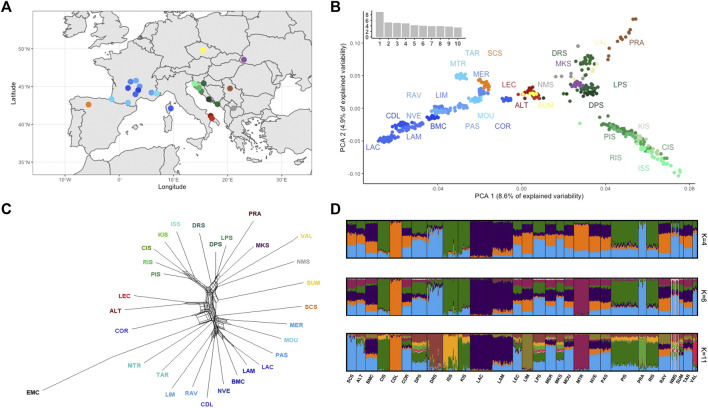FIGURE 2.
(A) Map of the origin of the breeds used in the Mediterranean dataset; (B) PCA plot for Mediterranean sheep breeds with principal component 1 and principal component 2.; (C) Neighbour network based on the Nei genetic distances constructed for Mediterranean dataset; (D) Graphical presentations of the population structure analyses for a sample of 574 Mediterranean sheep. Each sheep is represented by a single vertical line broken into K colour segments, with lengths proportional to the estimated membership of the inferred cluster. Each country is presented with different colour: Croatia—green; France—blue; Spain—orange; Italy—red; North-Macedonia—grey; Ukraine—purple; Czech Republic—yellow; Serbia—brown. Within a country, each breed is represented with a different main colour and three-letter coding: DRS, Dubrovnik Sheep; LPS, Lika Pramenka; DPS, Dalmatian Pramenka; PIS, Pag Island Sheep; RIS, Rab Island Sheep; CIS, Cres Island Sheep; KIS, Krk Island Sheep; ISS, Istrian Sheep; PRA, Serbian Pramenka; VAL, Valachian; MKS, Mount Carpatian Sheep; NMS, North Macedonian Pramenka; SUM, Sumavaska; ALT, Altamunrana; LEC, Leccese; SCS, Churra; COR, Corse; MER, Merino; NVE, Noire du Velay; CDL, Causse du Lot; RAV, Rava; BMC, Blanche du Massif Central; LAM, Meat Lacaune; LAC, Milk Lacaune; LIM, Limousine; TAR, Tarasconnaise; MTR, Manech Tete Rouge; PAS, Preaples du Sud; MOU, Mourerous.

